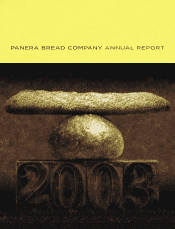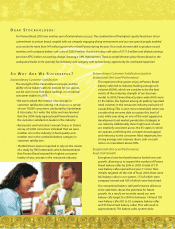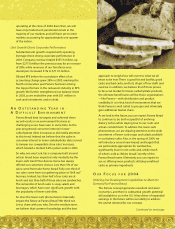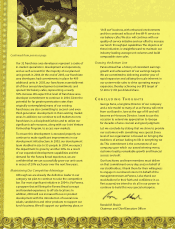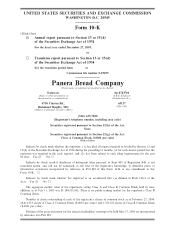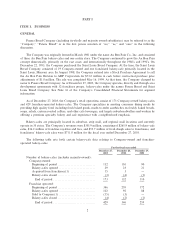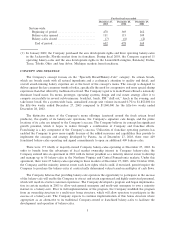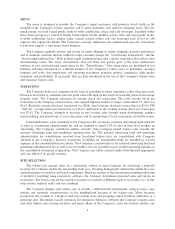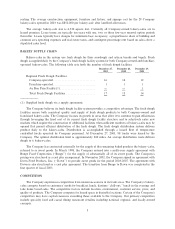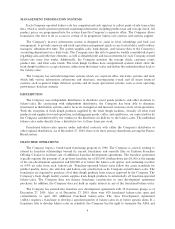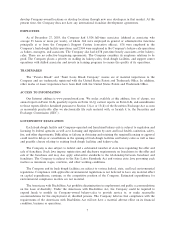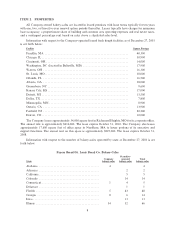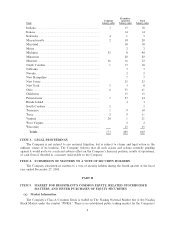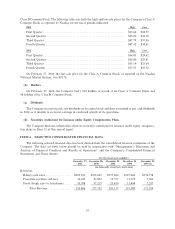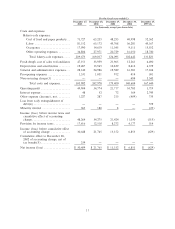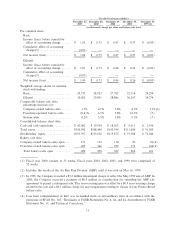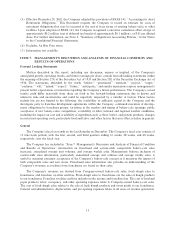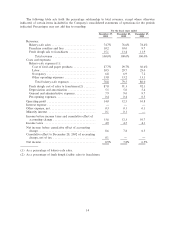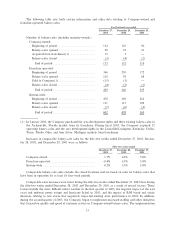Panera Bread 2003 Annual Report Download - page 9
Download and view the complete annual report
Please find page 9 of the 2003 Panera Bread annual report below. You can navigate through the pages in the report by either clicking on the pages listed below, or by using the keyword search tool below to find specific information within the annual report.
seating. The average construction, equipment, furniture and Ñxture, and signage cost for the 29 Company
bakery-cafes opened in 2003 was $850,000 per bakery-cafe after landlord allowances.
The average bakery-cafe size is 4,330 square feet. Currently all Company-owned bakery-cafes are in
leased premises. Lease terms are typically ten years with one, two, or three Ñve-year renewal option periods
thereafter. Leases typically have charges for minimum base occupancy, a proportionate share of building and
common area operating expenses and real estate taxes, and contingent percentage rent based on sales above a
stipulated sales level.
BAKERY SUPPLY CHAIN
Bakery-cafes in the system use fresh dough for their sourdough and artisan breads and bagels. Fresh
dough is supplied daily by the Company's fresh dough facility system for both Company-owned and franchise-
operated bakery-cafes. The following table sets forth the number of fresh dough facilities:
December 27, December 28, December 29,
2003 2002 2001
Regional Fresh Dough Facilities:
Company-operatedÏÏÏÏÏÏÏÏÏÏÏÏÏÏÏÏÏÏÏÏÏÏÏÏÏÏÏÏÏ 16 14 12
Franchise-operatedÏÏÏÏÏÏÏÏÏÏÏÏÏÏÏÏÏÏÏÏÏÏÏÏÏÏÏÏÏ 1 1 1
Au Bon Pain Facility(1)ÏÏÏÏÏÏÏÏÏÏÏÏÏÏÏÏÏÏÏÏÏÏÏÏ Ì Ì 1
Total Fresh Dough Facilities ÏÏÏÏÏÏÏÏÏÏÏÏÏÏÏÏÏÏÏÏ 17 15 14
(1) Supplied fresh dough via a supply agreement.
The Company believes its fresh dough facility system provides a competitive advantage. The fresh dough
facilities ensure both consistent quality and supply of fresh dough products to both Company-owned and
franchised bakery-cafes. The Company focuses its growth in areas that allow it to continue to gain eÇciencies
through leveraging the Ñxed cost of its current fresh dough facility structure and to selectively enter new
markets which require the construction of additional facilities when suÇcient numbers of bakery-cafes may be
opened that permit eÇcient distribution of the fresh dough. The fresh dough distribution system delivers
product daily to the bakery-cafes. Distribution is accomplished through a leased Öeet of temperature
controlled trucks operated by Company personnel. At December 27, 2003, 98 trucks were leased by the
Company. The optimal distribution limit is approximately 200 miles. An average distribution route delivers
dough to 6 bakery-cafes.
The Company has contracted externally for the supply of the remaining baked goods in the bakery-cafes,
referred to as sweet goods. In March 1998, the Company entered into a multi-year supply agreement with
Bunge Food Corporation (""Bunge'') for the supply of substantially all of its sweet goods. The Company's
pricing was structured as a cost plus arrangement. In November 2002, the Company signed an agreement with
Dawn Food Products, Inc. (""Dawn'') to provide sweet goods for the period 2003-2007. The agreement with
Dawn is also structured as a cost plus agreement. The transition from Bunge to Dawn was completed in the
Ñrst quarter of Ñscal 2003.
COMPETITION
The Company experiences competition from numerous sources in its trade areas. The Company's bakery-
cafes compete based on customers' needs for breakfast, lunch, daytime ""chill-out,'' lunch in the evening, and
take home bread sales. The competitive factors include location, environment, customer service, price, and
quality of products. The Company competes for leased space in desirable locations. Certain of the Company's
competitors may have capital resources exceeding those available to the Company. Our primary competitors
include specialty food and casual dining restaurant retailers including national, regional, and locally-owned
concepts.
5

